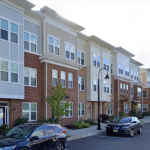New Jersey Future Blog
Aging-friendly housing options: A case study
May 5th, 2020 by New Jersey Future staff
Author: Tom Kozma
As baby boomers retire and young people look to start their careers, it is becoming apparent that many New Jersey towns don’t have the variety of housing options necessary to meet the needs of all their residents. While single family homes can be a great fit for many families, older generations might find them unnecessarily expensive or difficult to maintain. As part of its Creating Great Places to Age program, New Jersey Future has been researching strategies that dozens of municipalities in New Jersey have implemented to provide a more diverse housing stock. Having examples of successful local strategies will demonstrate possible paths other towns can take to meet the needs of their residents and develop great communities.

In line with national trends, in one decade the 65+ age cohort will grow to one in five New Jerseyans. Survey results from the AARP show most older adults want to stay in their current homes and communities as long as possible (76% and 77%, respectively), but many see obstacles ahead. At least half of respondents see walkable and affordable neighborhoods that make it easy to connect with their community through volunteering, social events, and flexible jobs as vital. Unfortunately, the built environment often makes this difficult. The Creating Great Places to Age program seeks to encourage strategies that make these desirable neighborhoods possible.
Form-based codes are one of the most promising strategies. Such codes are a revolution in the traditional theory of zoning, which focuses on dividing areas in towns into separate uses. A form-based code instead regulates the density and design of buildings. This allows developers to mix homes and civic buildings with retail businesses and offices in an aesthetically pleasing way. In a way, it ensures the purpose of zoning is to promote public health and development without micromanaging every lot. Compared to making minor tweaks in a zoning code, that’s revolutionary.
Beginning in 2005, the town of Newton, a small town of under ten thousand people, held focus groups with active citizens to come up with a vision plan for their town’s future. The residents came up with a strategic vision that aligns with many of the principles of smart growth and pedestrian-oriented development. They envisioned a tight-knit town both socially and physically, centered on a unique mixed-use downtown. In 2008, the town adopted its first major update to its master plan in over a decade. This plan called for a dual approach of redevelopment and historic preservation.
A few years later in 2012, Newton completely overhauled its zoning code into a form-based code. Instead of traditional zoning districts, it uses Transect Zones ranging from preserved natural space to the town core. These zones guide developers in what level of density the town is looking for in a specific area. This development pattern more closely resembles the way in which some small towns evolved before comprehensive zoning laws swept the country, before the proliferation of cars.
Form-based codes are a great strategy for towns with vibrant downtowns, as the mix of uses encourages activity and economic growth. Municipalities throughout New Jersey have adopted form-based codes, such as Hammonton in 2011 and Dover in 2006, for the whole town and the downtown area respectively.
There are other tools available for towns that still keep the basic principles of traditional use-based zoning. Many towns are allowing accessory dwelling units (ADUs), also known as granny flats or in-law apartments. These small self-contained living spaces share a parcel with a main house. ADUs can be attached to the main building, detached, part of a garage, or set up in other ways. They can be permitted with certain conditions, such as requiring that either the main or accessory unit be occupied by the property owner. When done in a way that’s consistent with existing neighborhood design, ADUs can be a great strategy to increase density while still allowing towns to maintain their desired character or keep their small-town feel.
More towns are allowing ADUs in some form, but policies differ among towns. Some towns in New York, for example, allow them only in limited circumstances, or restrict them to low-income older residents. In many cases, these units are a way for towns to meet their state obligations to build affordable housing. By integrating these affordable units with market-rate units, older residents are themselves integrated with the rest of the local residents. Sometimes, the town heavily subsidizes the construction of ADUs to make them a more attractive option for people with lower incomes.
For example, several municipalities in Hunterdon County amended their code to allow temporary ADUs designated for older residents—also known as Elder Cottage Housing Opportunities (ECHO)—in all single-family zones. A similar ordinance adopted in Washington Township in Morris County subsidizes the construction of several tiny homes on rural lots. These mobile houses, no more than 300 square feet, are reserved for veterans as transitional housing.
Whether taking a giant leap or a small step, there are New Jersey towns that have taken action. New Jersey faces the dual challenge of meeting the needs of an aging population and the needs of young people leaving the state; the high cost of housing is a key cause of the latter and will make the former a much more difficult transition. Making New Jersey work for everyone depends on having a myriad of housing strategies.
Related Posts
Tags: aging-friendly, Case study, vibrant downtown, walkable communities
















